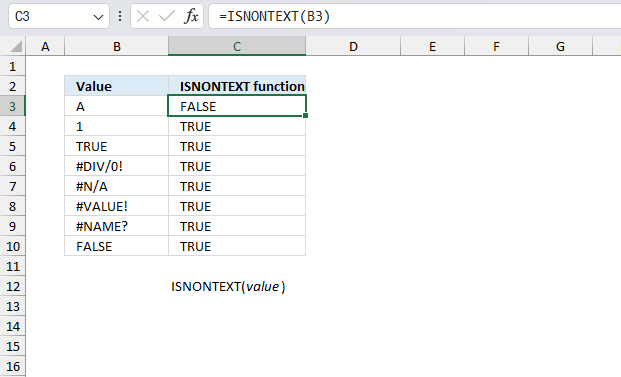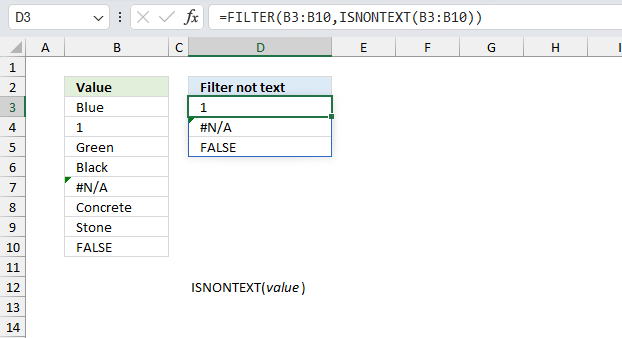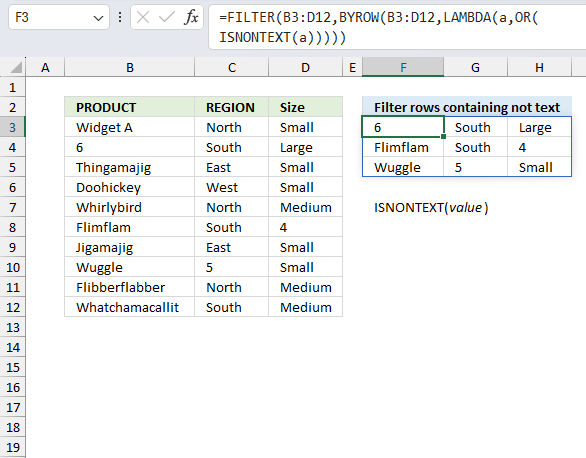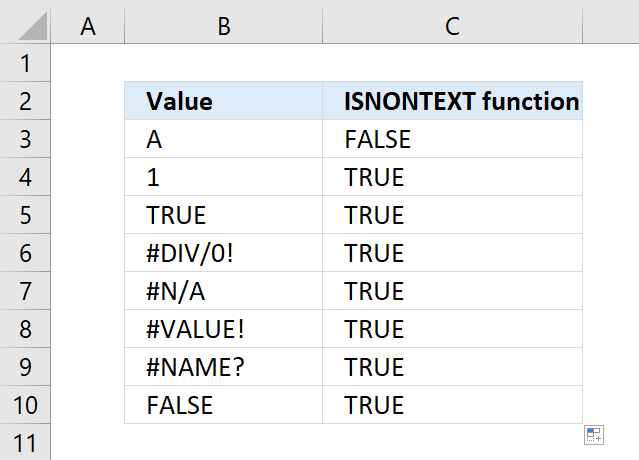How to use the ISNONTEXT function
What is the ISNONTEXT function?
The ISNONTEXT function returns TRUE if value is not text and FALSE if the cell content is a text value. It also returns TRUE if cell is empty.
Table of Contents
1. Introduction
What data types can a cell in Excel contain?
A cell can contain these types of data:
- Numbers: Whole numbers, decimals, dates, and times.
- Text: Alphanumeric characters, such as words, phrases, and sentences.
- Formulas: Mathematical expressions that perform calculations and return a value.
- Errors: Error messages that occur when a formula or function is invalid or cannot be calculated.
- Blank: An empty cell that contains no data.
What is a Boolean value?
A Boolean value in Excel is a value that can only be TRUE or FALSE. It represents binary logic and is the result of a logical expression using logical operators or a result of a few Excel functions.
Mastering Boolean logic and logical expressions is key to manipulating data and controlling workflow in Excel.
What is non text?
Excel tries to identify inserted values automatically, text values are left-aligned. Boolean values and error values are centered in cells, and numerical values are right-aligned. This automatic formatting is really useful, however, an Excel user may change the formatting which makes it impossible to see what type of data a cell contains. Further analysis is needed to accurately determine the data type. The ISNONTEXT function is one of many tools to identify the data type.
Cells containing anything except text values evaluates to TRUE by the ISNONTEXT function. The ISNONTEXT function lets you check a value in a formula instead of visually identify values by their position in a cell.
Other IS functions
| Excel Function | Description |
|---|---|
| ISBLANK(value) | Returns TRUE if the value is empty, FALSE otherwise |
| ISERR(value) | Returns TRUE if the value is any error value except #N/A, FALSE otherwise |
| ISERROR(value) | Returns TRUE if the value is any error value, FALSE otherwise |
| ISEVEN(value) | Returns TRUE if the value is an even number, FALSE for odd numbers |
| ISFORMULA(reference) | Returns TRUE if the cell contains a formula, FALSE otherwise |
| ISLOGICAL(value) | Returns TRUE if the value is a logical value (TRUE/FALSE), FALSE otherwise |
| ISNA(value) | Returns TRUE if the value is the #N/A error, FALSE otherwise |
| ISNONTEXT(value) | Returns TRUE if the value is not text, FALSE if it is text |
| ISNUMBER(value) | Returns TRUE if the value is a number, FALSE otherwise |
| ISODD(value) | Returns TRUE if the value is an odd number, FALSE for even numbers |
2. Syntax
ISNONTEXT(value)
| value | Required. The value you want to check if not text. |
3. Example 1

The image above shows a worksheet with values populated in column B, they are all left-aligned by me. The first cell B3 contains "A" which is a text value. The function returns FALSE in cell C3 because the value is a text value.
The second cell B4 contains "1" which is a numerical value. The function returns TRUE in cell C4 because the value is NOT a text value.
The third cell B5 contains TRUE which is a boolean value. The function returns TRUE in cell C5 because the value is NOT a text value.
Cells B6 to B9 contain errors, the function returns TRUE in cells C6:C9 because the values are NOT a text values.
Cell B10 contains FALSE which is also a boolean value. The function returns TRUE in cell C10, FALSE is not a text value.
Formula in cell C3:
The ISNONTEXT function is very useful to identify error values in arrays. Most Excel functions return the same error value, however, this function returns FALSE if it encounters an error.
4. Example 2

This example demonstrates an Excel 365 dynamic array formula that extracts non text values from cell range B3:B10. The formula spills values automatically to adjacent cells if needed as far as necessary.
Cell range B3:B10 contains the following values: Blue, 1, Green, Black, #N/A, Concrete, Stone, FALSE
Formula in cell D3:
The formula in cell D3 returns 1, #N/A, and FALSE. These are not text values, the first value 1 is a numerical vale, the second value #N/A is an error value, and the third value FALSE is a boolean value.
Explaining formula
Step 1 - Determine if the data type is non text
ISNONTEXT(B3:B10)
returns
{FALSE;TRUE;FALSE;FALSE;TRUE;FALSE;FALSE;TRUE}
Step 2 - Filter non text values
The FILTER function extracts values/rows based on a condition or criteria.
Function syntax: FILTER(array, include, [if_empty])
FILTER(B3:B10,ISNONTEXT(B3:B10))
becomes
FILTER(B3:B10,{FALSE;TRUE;FALSE;FALSE;TRUE;FALSE;FALSE;TRUE})
and returns {1;#N/A;FALSE}
5. Example 3

This example shows how to filter rows that contain at least one non text cell value. The source data is in cell range B3:D12 and contains made up data in these columns: Product, Region, and Size.
Formula in cell F3:
The formula filters the data in cell range B3:D12 and returns the following rows B4:D4, B8:D8, and B10:D10. They all contain non text values, specifically in cells B4, D8, and C10.
5.1 Explaining formula
Step 1 - Determine which cells contain non text values
Variable a will be defined in step 3 by the LAMBDA function, it will contain values from each row.
ISNONTEXT(a)
The ISNON function returns TRUE or FALSE based on the values data type.
Step 2 - Return TRUE if at least one of the cells contain a non text value
The OR function evaluates a logical expression in each argument and if at least one argument returns TRUE the OR function returns TRUE. If all arguments return FALSE the OR function also returns FALSE.
Function syntax: OR(logical1, [logical2])
OR(ISNONTEXT(a))
The OR function returns TRUE if at least one of the values is a non text value.
Step 3 - Define variable in LAMBDA function
The LAMBDA function build custom functions without VBA, macros or javascript.
Function syntax: LAMBDA([parameter1, parameter2, …,] calculation)
LAMBDA(a,OR(ISNONTEXT(a)))
The LAMBDA function is needed for the BYROW function to work properly.
Step 4 - Specify cell reference in BYROW function
The BYROW function puts values from an array into a LAMBDA function row-wise.
Function syntax: BYROW(array, lambda(array, calculation))
BYROW(B3:D12,LAMBDA(a,OR(ISNONTEXT(a))))
The BYROW function will pass each row of values to the LAMBDA function, row-wise is important in order to fetch the corresponding rows in the next step.
Step 5 - Filter rows based on boolean values
The FILTER function extracts values/rows based on a condition or criteria.
Function syntax: FILTER(array, include, [if_empty])
FILTER(B3:D12, BYROW(B3:D12,LAMBDA(a,OR(ISNONTEXT(a)))))
The FILTER function filters out all rows containing only text values returning only rows with at least one non text value.
6. Function not working

The ISNONTEXT function returns
- #NAME? error if you misspell the function name.
- #SPILL! error if if it is attempting to output multiple results into adjacent cells, but those cells are already occupied or obstructed by other data.
6.1 Troubleshooting the error value

When you encounter an error value in a cell a warning symbol appears, displayed in the image above. Press with mouse on it to see a pop-up menu that lets you get more information about the error.
- The first line describes the error if you press with left mouse button on it.
- The second line opens a pane that explains the error in greater detail.
- The third line takes you to the "Evaluate Formula" tool, a dialog box appears allowing you to examine the formula in greater detail.
- This line lets you ignore the error value meaning the warning icon disappears, however, the error is still in the cell.
- The fifth line lets you edit the formula in the Formula bar.
- The sixth line opens the Excel settings so you can adjust the Error Checking Options.
Here are a few of the most common Excel errors you may encounter.
#NULL error - This error occurs most often if you by mistake use a space character in a formula where it shouldn't be. Excel interprets a space character as an intersection operator. If the ranges don't intersect an #NULL error is returned. The #NULL! error occurs when a formula attempts to calculate the intersection of two ranges that do not actually intersect. This can happen when the wrong range operator is used in the formula, or when the intersection operator (represented by a space character) is used between two ranges that do not overlap. To fix this error double check that the ranges referenced in the formula that use the intersection operator actually have cells in common.
#SPILL error - The #SPILL! error occurs only in version Excel 365 and is caused by a dynamic array being to large, meaning there are cells below and/or to the right that are not empty. This prevents the dynamic array formula expanding into new empty cells.
#DIV/0 error - This error happens if you try to divide a number by 0 (zero) or a value that equates to zero which is not possible mathematically.
#VALUE error - The #VALUE error occurs when a formula has a value that is of the wrong data type. Such as text where a number is expected or when dates are evaluated as text.
#REF error - The #REF error happens when a cell reference is invalid. This can happen if a cell is deleted that is referenced by a formula.
#NAME error - The #NAME error happens if you misspelled a function or a named range.
#NUM error - The #NUM error shows up when you try to use invalid numeric values in formulas, like square root of a negative number.
#N/A error - The #N/A error happens when a value is not available for a formula or found in a given cell range, for example in the VLOOKUP or MATCH functions.
#GETTING_DATA error - The #GETTING_DATA error shows while external sources are loading, this can indicate a delay in fetching the data or that the external source is unavailable right now.
6.2 The formula returns an unexpected value

To understand why a formula returns an unexpected value we need to examine the calculations steps in detail. Luckily, Excel has a tool that is really handy in these situations. Here is how to troubleshoot a formula:
- Select the cell containing the formula you want to examine in detail.
- Go to tab “Formulas” on the ribbon.
- Press with left mouse button on "Evaluate Formula" button. A dialog box appears.
The formula appears in a white field inside the dialog box. Underlined expressions are calculations being processed in the next step. The italicized expression is the most recent result. The buttons at the bottom of the dialog box allows you to evaluate the formula in smaller calculations which you control. - Press with left mouse button on the "Evaluate" button located at the bottom of the dialog box to process the underlined expression.
- Repeat pressing the "Evaluate" button until you have seen all calculations step by step. This allows you to examine the formula in greater detail and hopefully find the culprit.
- Press "Close" button to dismiss the dialog box.

There is also another way to debug formulas using the function key F9. F9 is especially useful if you have a feeling that a specific part of the formula is the issue, this makes it faster than the "Evaluate Formula" tool since you don't need to go through all calculations to find the issue..
- Enter Edit mode: Double-press with left mouse button on the cell or press F2 to enter Edit mode for the formula.
- Select part of the formula: Highlight the specific part of the formula you want to evaluate. You can select and evaluate any part of the formula that could work as a standalone formula.
- Press F9: This will calculate and display the result of just that selected portion.
- Evaluate step-by-step: You can select and evaluate different parts of the formula to see intermediate results.
- Check for errors: This allows you to pinpoint which part of a complex formula may be causing an error.
The image above shows cell reference B4:B5 converted to hard-coded value using the F9 key. The ISNONTEXT function requires, in this setup, a single value, which is not the case in this example. We have found what is wrong with the formula.
Tips!
- View actual values: Selecting a cell reference and pressing F9 will show the actual values in those cells.
- Exit safely: Press Esc to exit Edit mode without changing the formula. Don't press Enter, as that would replace the formula part with the calculated value.
- Full recalculation: Pressing F9 outside of Edit mode will recalculate all formulas in the workbook.
Remember to be careful not to accidentally overwrite parts of your formula when using F9. Always exit with Esc rather than Enter to preserve the original formula. However, if you make a mistake overwriting the formula it is not the end of the world. You can “undo” the action by pressing keyboard shortcut keys CTRL + z or pressing the “Undo” button
6.3 Other errors
Floating-point arithmetic may give inaccurate results in Excel - Article
Floating-point errors are usually very small, often beyond the 15th decimal place, and in most cases don't affect calculations significantly.
Functions in 'Information' category
The ISNONTEXT function function is one of 19 functions in the 'Information' category.

How to comment
How to add a formula to your comment
<code>Insert your formula here.</code>
Convert less than and larger than signs
Use html character entities instead of less than and larger than signs.
< becomes < and > becomes >
How to add VBA code to your comment
[vb 1="vbnet" language=","]
Put your VBA code here.
[/vb]
How to add a picture to your comment:
Upload picture to postimage.org or imgur
Paste image link to your comment.
Contact Oscar
You can contact me through this contact form